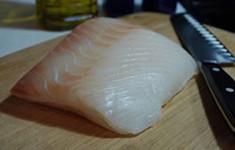 Retail prices on halibut soared for the first week of Alaskan halibut season — which started 23 March — and overall remained strong because of supply challenges.
Retail prices on halibut soared for the first week of Alaskan halibut season — which started 23 March — and overall remained strong because of supply challenges.Many supermarket chains started out the season with USD 20 (EUR 15.25) a pound halibut fillets and some have dropped their prices — but only slightly.
“Prices came down somewhat, but the bad weather in Alaska has made product tight this week and prices are firming quite a bit for the first part of the week,” Dan Pryor, senior purchaser for wholesaler and retailer Santa Monica Seafood,” told SeafoodSource.
Whole Foods Market is the exception to the premium-pricing scenario, with a significant price discount on halibut this week. This Friday, April 12, the retailer is holding a one-day sale on fresh, MSC-certified halibut steaks at all of its U.S. and Toronto stores. On Friday, Whole Foods is retailing halibut for USD 12.88 (EUR 9.82) a pound, which it says is an average savings of 40 percent. “Halibut season just opened in Alaska and our own Whole Foods Market port buyers are taking full advantage to ship us the finest (and freshest) catches straight from the source,” according to Whole Foods’ Whole Story blog.
Other supermarket chains are buying the whole halibut, cutting it into steaks, and using other parts of the fish. “They are selling the tail pieces too. There is very little waste,” Harry Mahleres, director of purchasing for Seattle Fish Co., Denver, told SeafoodSource.
The average wholesale prices have on fresh halibut have only decreased slightly, with distributors reporting USD 16.50 (EUR 12.58) to USD 16.90 (EUR 12.89) a pound for fillets, and between USD 6.25 (EUR 4.77) and USD 7.50 (EUR 5.72) a pound FOB for 10 to 20 pounds whole, and USD 7.25 (EUR 5.53) to USD 8.75 (EUR 6.67) a pound FOB for 40 pounds or more whole.
As a result of initial high pricing, some restaurants held back from featuring halibut at the start of the season. “Some of the foodservice guys were put off by the starting high prices…but the white tablecloth restaurants are jumping on board,” Mahleres said.
Even though this season’s quota was slashed by around 10 percent to 31 million pounds, that should not drive prices higher than last season, according to Mahleres.
“The price impact will be mitigated by the amount of frozen product for sale from last year. I think prices are going to be pretty similar to last year, because there is still a lot of frozen inventory on hand,” he said.
Plus, distributors report steady demand — with no significant spikes — compared to last year.
“We haven’t seen a lot of people switching out from whatever they were doing before the halibut season started to add halibut,” Pryor said.





